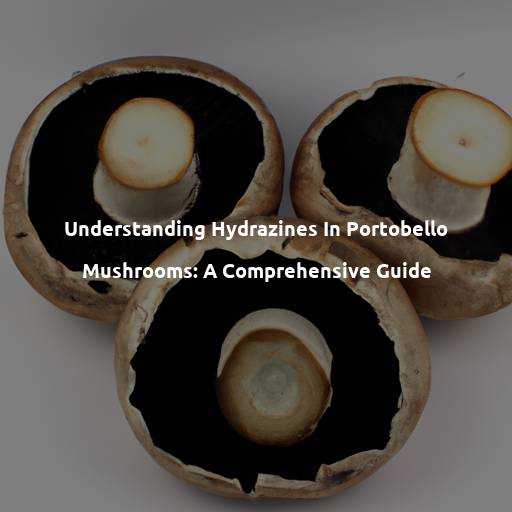Introduction to Hydrazines in Portobello Mushrooms
Hydrazines in Portobello Mushrooms are a topic of growing concern among mushroom enthusiasts and health-conscious individuals. In recent years, there has been an increased focus on understanding the presence of hydrazines and their potential effects on human health. This comprehensive guide aims to provide you with a thorough understanding of hydrazines in Portobello mushrooms, as well as practical tips for minimizing exposure and enjoying these mushrooms safely. Whether you’re a seasoned mushroom lover or just starting to explore the world of Portobellos, this guide will equip you with the knowledge you need to make informed decisions about consuming these delicious fungi. So, let’s dive in and explore the complex world of hydrazines in Portobello mushrooms.
What are Hydrazines and How They Affect Portobello Mushrooms
Hydrazines are a group of organic compounds that can be found naturally in various types of mushrooms, including portobello mushrooms. These compounds are formed through the enzymatic breakdown of certain amino acids during the growth and development of the mushrooms.
In portobello mushrooms, hydrazines primarily exist in the form of agaritine. Agaritine is a specific hydrazine compound that has been the focus of scientific research due to its potential health effects. When portobello mushrooms are cooked, agaritine can break down into smaller components, including hydrazine, which raises concerns about its impact on human health.
The presence of hydrazines in portobello mushrooms has been associated with both beneficial and detrimental effects. On one hand, hydrazines possess antioxidant and antimicrobial properties that may have potential health benefits. On the other hand, studies have suggested a possible link between hydrazine consumption and an increased risk of certain health conditions, such as liver cancer and genotoxicity.
The precise mechanisms by which hydrazines affect portobello mushrooms and their impact on human health are still being investigated. It is important to note that the levels of hydrazines in portobello mushrooms can vary depending on several factors, including the mushroom’s age, cultivation methods, and storage conditions.
To ensure food safety, it is recommended to minimize hydrazine exposure by properly cooking portobello mushrooms. Cooking at high temperatures can help break down agaritine and reduce the levels of hydrazines. Additionally, consuming a balanced and varied diet, including a variety of mushroom types, can help mitigate any potential risks associated with hydrazines.
In conclusion, while hydrazines naturally occur in portobello mushrooms, further research is needed to fully understand their effects on both the mushrooms themselves and human health. By being mindful of cooking methods and maintaining a diverse diet, individuals can continue to enjoy portobello mushrooms safely.
Potential Health Risks of Consuming Hydrazines
Hydrazines in Portobello mushrooms can pose potential health risks if consumed in large quantities or contaminated forms. While these compounds are naturally occurring in some mushroom species, the levels found in Portobellos are generally low and considered safe for consumption. However, it is important to be aware of the potential risks associated with consuming hydrazines.
Excessive consumption of hydrazines can lead to adverse health effects. One of the main concerns is the potential for liver damage, as hydrazines have been found to be hepatotoxic. Liver toxicity can manifest in various ways, such as liver inflammation, damage to liver cells, and impairment of liver function.
Moreover, studies have suggested a potential link between hydrazine exposure and increased risk of certain types of cancers. The International Agency for Research on Cancer (IARC) has classified one specific hydrazine compound, known as N-nitrosopiperazine (NPIP), as a possible human carcinogen. However, it’s important to note that the levels of NPIP found in Portobello mushrooms are generally low and unlikely to pose a significant risk.
It is worth mentioning that cooking Portobello mushrooms can help reduce hydrazine levels, as heat can partially break down these compounds. Therefore, it is recommended to thoroughly cook Portobellos before consuming them to minimize the potential health risks.
Although the health risks associated with consuming hydrazines in Portobello mushrooms are generally low, it is always advisable to practice moderation and choose mushrooms from reliable sources. If you have any concerns or experience any adverse effects after consuming Portobellos, it is best to consult a healthcare professional for further guidance.
Overall, understanding the potential health risks of consuming hydrazines in Portobello mushrooms is essential for maintaining a safe and enjoyable culinary experience. By being aware and taking necessary precautions, you can continue to enjoy these delicious fungi while minimizing any potential risks.
How to Identify Hydrazine Contamination in Portobello Mushrooms
Hydrazine contamination in portobello mushrooms can be concerning, but with proper knowledge, it is possible to identify potential contamination and ensure your safety. Here are some key factors to consider when identifying hydrazine contamination in portobello mushrooms:
1. Visual assessment: Examine the mushrooms closely for any signs of discoloration, mold growth, or unusual spots. Hydrazine-contaminated mushrooms may exhibit dark spots, blackened areas, or abnormal blemishes on the surface.
2. Odor detection: Trust your sense of smell. Fresh portobello mushrooms should have a mild, earthy aroma. If you detect any unusual or pungent odors, it could be an indication of contamination.
3. Texture and consistency: Hydrazine-contaminated mushrooms might feel slimy or have a mushy texture. Pay attention to any changes in the mushroom’s firmness or if it feels overly soft or soggy.
4. Purchase from reputable sources: To minimize the risk of hydrazine contamination, choose portobello mushrooms from trusted suppliers or farmers’ markets. Established sources often adhere to rigorous quality control measures to ensure safe produce.
5. Storage conditions: Improper storage of portobello mushrooms can accelerate bacterial growth, potentially increasing the risk of hydrazine contamination. Ensure that you store mushrooms at the appropriate temperature and humidity levels to maintain their freshness and minimize contamination possibilities.
6. Conduct a water test: Another way to identify potential hydrazine contamination is by conducting a simple water test. Immerse the mushrooms in clean water and observe for any discoloration or the release of particles. If the water turns dark or shows unusual particles, it could indicate contamination.
Remember, although the presence of hydrazine contamination is not common in portobello mushrooms, being cautious and aware of the potential risks is essential. Regularly inspecting and properly handling mushrooms will help ensure a safe and enjoyable culinary experience.
Tips for Minimizing Hydrazine Exposure
To reduce the risk of hydrazine exposure while enjoying delicious portobello mushrooms, here are some helpful tips:
1. Choose reputable sources: Purchase portobello mushrooms from trusted suppliers who follow strict quality control standards. This ensures that the mushrooms are fresh and free from contaminants.
2. Thoroughly inspect mushrooms: Before cooking, carefully examine the portobello mushrooms for any signs of spoilage, including discoloration, sliminess, or a foul odor. Avoid consuming mushrooms that appear to be damaged or in poor condition.
3. Properly wash mushrooms: Rinse portobello mushrooms under cool running water to remove any dirt or debris. Gently pat them dry with a clean paper towel to prevent water from lingering, as excess moisture can promote bacterial growth.
4. Cook mushrooms thoroughly: Hydrazines can be partially destroyed through cooking. Ensure that portobello mushrooms are cooked thoroughly to minimize the remaining levels of hydrazine. It is recommended to cook them until the internal temperature reaches at least 160°F (71°C).
5. Avoid excessive consumption: While portobello mushrooms can be a delicious addition to your meals, it is recommended to consume them in moderation. By diversifying your diet and not solely relying on mushrooms as a primary food source, you can reduce the potential risks associated with hydrazine exposure.
6. Store mushrooms properly: To maintain freshness and minimize the growth of bacteria, store portobello mushrooms in a cool, dry place. If storing them in the refrigerator, place them in a breathable container or wrap them loosely in paper towels to prevent moisture buildup.
Remember, these tips are meant to provide general guidance for minimizing hydrazine exposure in portobello mushrooms. It is always advisable to consult with a healthcare professional or nutritionist for personalized advice based on your specific needs and concerns.
Conclusion: Enjoying Portobello Mushrooms Safely
In conclusion, while hydrazines naturally occur in portobello mushrooms, it is important to take necessary precautions to enjoy them safely. By understanding the potential health risks associated with hydrazine consumption and implementing proper cooking methods, individuals can continue to incorporate portobello mushrooms into their diet without significant concern.
Cooking portobello mushrooms at high temperatures can help break down agaritine and reduce the levels of hydrazines. It is recommended to cook them until the internal temperature reaches at least 160°F (71°C) to ensure thorough cooking and minimize the remaining levels of hydrazine.
Additionally, it is advisable to consume a balanced and varied diet that includes a variety of mushroom types. This diversification can help mitigate any potential risks associated with hydrazines and provide a wider range of nutritional benefits.
Furthermore, it is essential to source portobello mushrooms from reputable suppliers or farmers’ markets to ensure their quality and minimize the risk of contamination. Regularly inspecting mushrooms for signs of spoilage, such as discoloration or unusual odors, is crucial before consumption.
By following these guidelines and practicing moderation, individuals can continue to enjoy the delicious flavors and nutritional benefits of portobello mushrooms while prioritizing their safety and well-being.
Remember, if you have any concerns or experience any adverse effects after consuming portobello mushrooms, it is always best to consult a healthcare professional for personalized advice and guidance.

